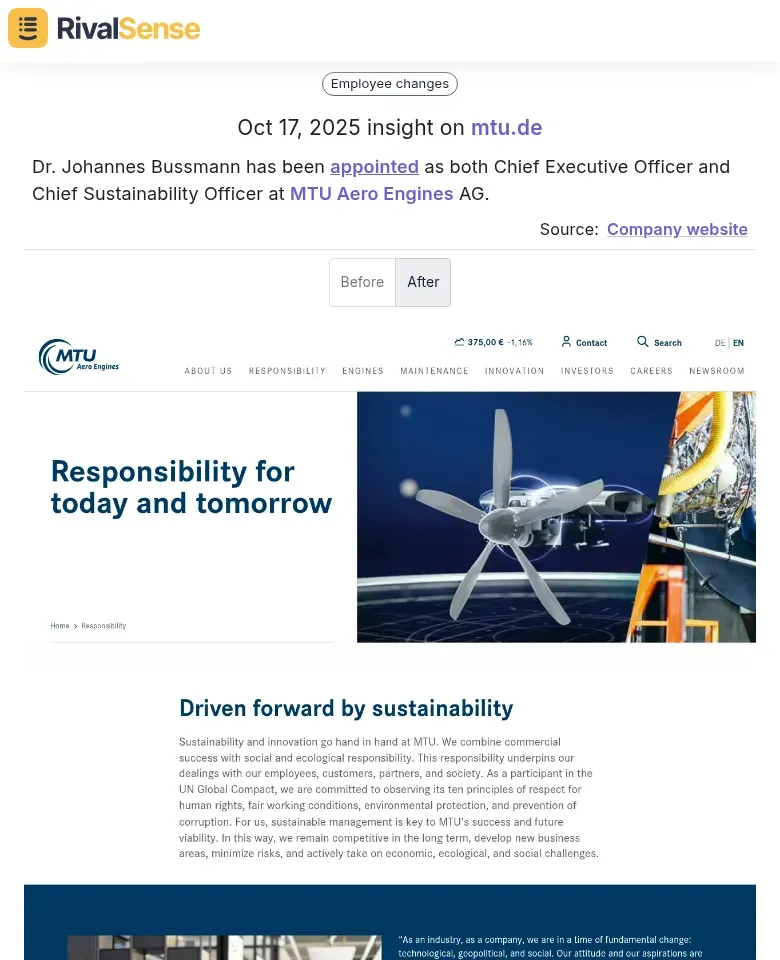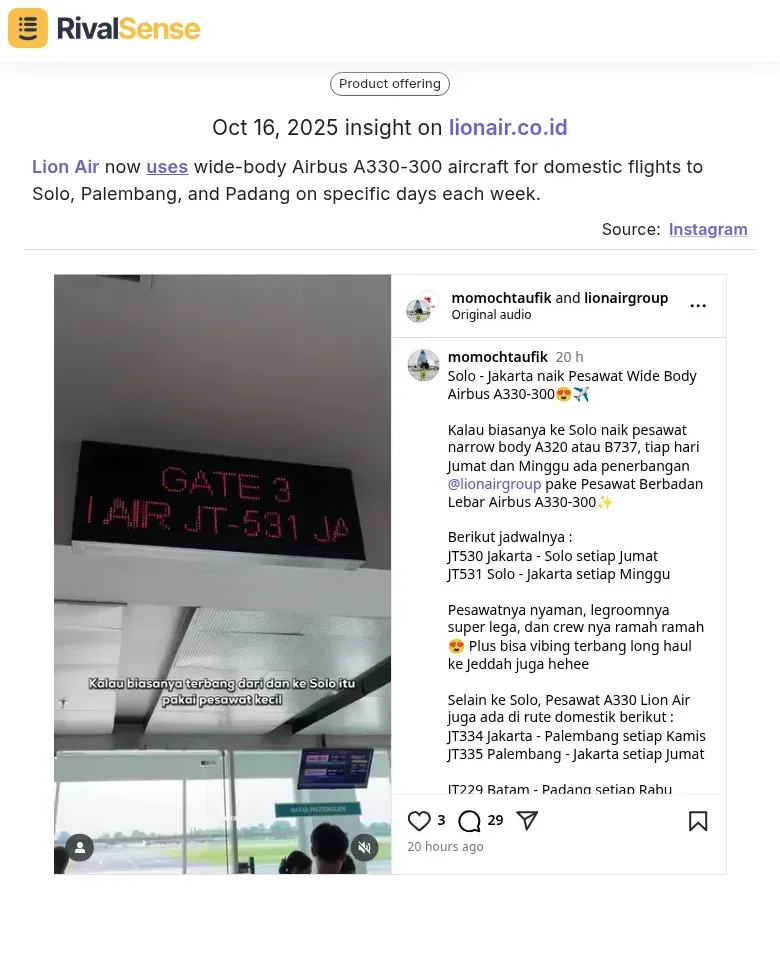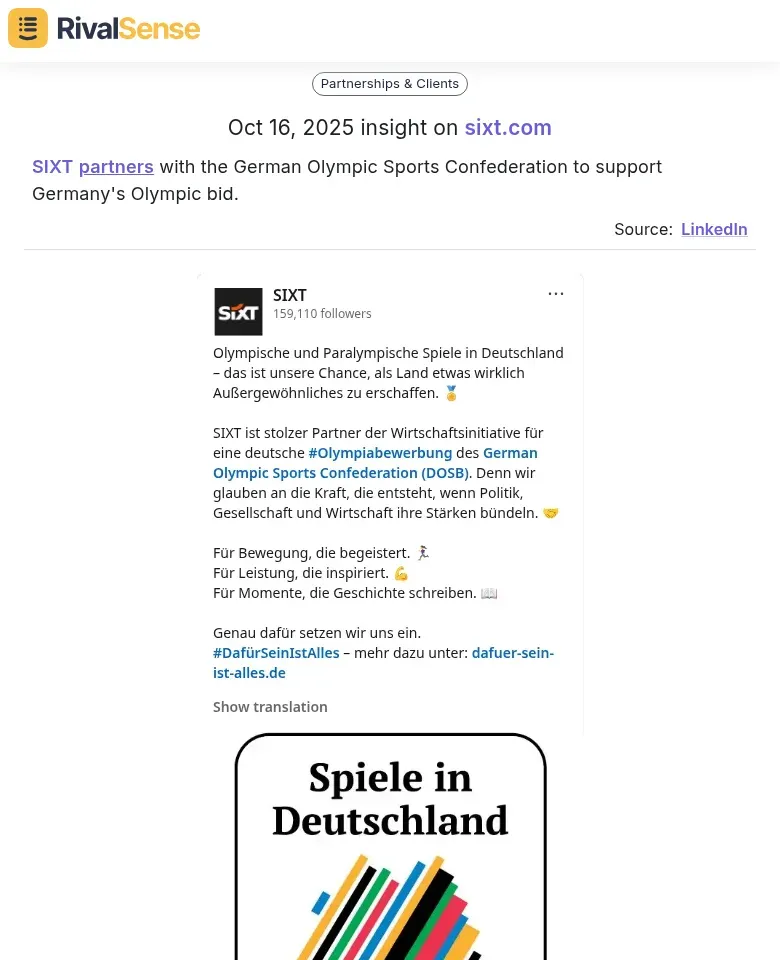Unlocking Competitor Pricing Advantages: A Strategic Guide for Business Leaders
In today's hyper-competitive B2B landscape, understanding and leveraging competitor pricing advantages is essential for maintaining market relevance and driving growth. As a founder or CEO, you know that pricing isn't just a number—it's a strategic tool that influences customer perception, market share, and profitability. But how do you consistently track and analyze competitor pricing moves to stay ahead?
Competitor pricing intelligence provides real-time insights into market dynamics, enabling you to:
- Real-time market positioning 🎯
- Customer perception management
- Strategic response capabilities
- Profit optimization opportunities
Moreover, comprehensive competitor monitoring goes beyond pricing alone. For example, management changes can signal shifts in corporate strategy that may impact pricing. When RivalSense detected that Dr. Johannes Bussmann has been appointed as both Chief Executive Officer and Chief Sustainability Officer at MTU Aero Engines AG, it indicated a potential focus on sustainability that could influence their product pricing and market approach.

This type of insight is valuable because it helps you anticipate strategic pivots before they affect pricing, allowing you to adjust your own strategy proactively and maintain a competitive edge.
8 Pricing Models That Give You Competitive Edge
Choosing the right pricing model is crucial for outperforming competitors and capturing market share. Each model offers unique advantages that can be tailored to your business goals and market conditions. Here are eight effective pricing strategies to consider:
1. Competitive Pricing Model: The Foundation of Market Intelligence
What it is: Setting prices based on direct competitor analysis
Strategic advantage: Positions you as either the value leader or premium alternative
Practical implementation checklist:
- ✅ Monitor 3-5 key competitors continuously
- ✅ Track price changes across product lines
- ✅ Analyze pricing patterns and timing
- ✅ Identify price gaps and opportunities
Pro tip: Tools like RivalSense automate competitor price tracking across 80+ sources, delivering weekly reports that highlight pricing changes before they impact your market share.
2. Value-Based Pricing: When Quality Commands Premium
What it is: Pricing based on customer-perceived value
Strategic advantage: Builds brand loyalty and justifies premium positioning
Implementation steps:
- Conduct customer value perception surveys
- Identify unique value propositions
- Quantify premium features financially
- Communicate value effectively
3. Penetration Pricing: The Market Entry Weapon
What it is: Aggressively low pricing to capture market share
Strategic advantage: Rapid customer acquisition and competitor disruption
Key considerations:
- Monitor competitor reactions closely
- Plan gradual price increases
- Ensure sustainable cost structure
- Track customer retention metrics
Product launches often involve aggressive pricing to gain market share. For example, Lion Air now uses wide-body Airbus A330-300 aircraft for domestic flights to Solo, Palembang, and Padang on specific days each week, suggesting capacity expansion that might come with competitive pricing to attract customers.

Monitoring product launches is valuable because it helps you identify when competitors are likely to use penetration pricing, enabling you to prepare targeted responses and protect your market position.
4. Price Skimming: Maximizing Early Adopter Revenue
What it is: High initial prices that decrease over time
Strategic advantage: Captures maximum value from innovation
When to use:
- Launching innovative products
- Limited competition scenarios
- Strong intellectual property protection
5. Bundle Pricing: The Cross-Sell Advantage
What it is: Combining products at discounted rates
Strategic advantage: Increases average order value and customer loyalty
Competitive angle: Analyze competitor bundling strategies to identify gaps
Partnerships are a common way to create bundling opportunities. For instance, SIXT partners with the German Olympic Sports Confederation to support Germany's Olympic bid, which could lead to exclusive travel packages or promotional pricing.

Tracking such partnerships is crucial because they can introduce new competitive dynamics and pricing models that require swift strategic adjustments to maintain your advantage.
6. Loss-Leader Pricing: The Strategic Sacrifice
What it is: Pricing one product below cost to drive sales of others
Strategic advantage: Customer acquisition and cross-selling opportunities
Warning: Monitor for predatory pricing compliance
7. Anchor Pricing: The Psychological Edge
What it is: Displaying original vs. discounted prices
Strategic advantage: Creates perceived value and urgency
Competitive application: Study how competitors use anchoring in promotions
8. Cost-Plus Pricing: The Stability Foundation
What it is: Markup-based pricing on total costs
Strategic advantage: Profit stability and predictable margins
Competitive context: Use as baseline while monitoring market dynamics
Practical Framework for Gaining Pricing Advantages
Implementing a structured approach to competitor pricing can transform random reactions into strategic wins. This framework helps you systematically monitor, analyze, and respond to competitor moves for sustained advantage.
Step 1: Continuous Competitor Monitoring
Actionable checklist:
- [ ] Identify primary and secondary competitors
- [ ] Track pricing across all product tiers
- [ ] Monitor promotional activities and timing
- [ ] Analyze pricing change frequency
- [ ] Document competitor pricing strategies
Implementation note: Manual tracking is time-consuming and often misses critical changes. Automated solutions like RivalSense provide comprehensive monitoring across websites, social media, and regulatory filings, ensuring you never miss a key update.
Step 2: Strategic Response Planning
Decision framework:
- Match: When maintaining market position is critical
- Undercut: When pursuing aggressive market share growth
- Premium: When emphasizing quality and value differentiation
- Bundle: When increasing customer lifetime value
Step 3: Timing and Execution
Critical timing factors:
- Competitor product launches
- Seasonal demand patterns
- Market entry/exit of players
- Regulatory changes
- Economic shifts
Advanced Competitive Pricing Intelligence
Moving beyond basic price matching allows you to anticipate competitor moves and stay ahead. Advanced intelligence involves analyzing deeper patterns and external factors that influence pricing strategies.
Dynamic Pricing Algorithms
Monitor how competitors adjust prices based on:
- Demand fluctuations
- Inventory levels
- Competitor stockouts
- Customer behavior patterns
Geographic Pricing Strategies
Track how competitors vary pricing across:
- Different markets/countries
- Urban vs. rural areas
- Online vs. offline channels
Customer Segment Pricing
Analyze competitor approaches to:
- Enterprise vs. SMB pricing
- Volume discount structures
- Loyalty program pricing
Building Your Competitive Pricing Advantage System
A robust system integrates technology, processes, and people to ensure consistent pricing advantages. This involves setting up the right tools and protocols for ongoing monitoring and response.
Essential Components:
- Real-time monitoring of competitor price changes
- Historical analysis of pricing patterns
- Alert systems for significant moves
- Response protocols for different scenarios
- Performance tracking of pricing decisions
Technology Integration:
Modern competitive intelligence platforms like RivalSense transform pricing strategy from reactive to proactive by:
- Automating data collection from 80+ sources
- Providing weekly consolidated reports
- Highlighting strategic opportunities
- Tracking competitor product and pricing updates
Key Metrics for Pricing Advantage Success 📊
Measuring the effectiveness of your pricing strategies ensures continuous improvement. Focus on these KPIs to gauge your competitive pricing performance and adjust as needed.
Monitor these KPIs to measure your competitive pricing effectiveness:
- Market share changes
- Customer acquisition cost
- Customer lifetime value
- Price elasticity impact
- Competitor response time
- Profit margin stability
Common Pricing Advantage Pitfalls to Avoid
Even with the best strategies, mistakes can undermine your efforts. Being aware of these common pitfalls helps you steer clear of costly errors and maintain a strong market position.
- Race to the bottom - Competing solely on price
- Reactionary pricing - Changing prices without strategy
- Ignoring value perception - Focusing only on competitor prices
- Missing timing opportunities - Slow response to market changes
- Incomplete competitor view - Monitoring only direct competitors
The Future of Competitive Pricing Intelligence
As technology evolves, so do the opportunities for gaining pricing advantages. Staying ahead means embracing new tools and approaches that leverage data and automation for smarter decisions.
With markets becoming more dynamic, the ability to quickly adapt pricing strategies based on competitor movements will separate market leaders from followers. The most successful companies will leverage:
- AI-powered price optimization
- Real-time competitor intelligence
- Predictive analytics for market shifts
- Automated response systems
Getting Started with Competitive Pricing Advantage
Taking the first steps toward a proactive pricing strategy doesn't have to be overwhelming. Start with these immediate actions to build momentum and see quick wins.
Immediate actions for this week:
- Map your current competitor pricing landscape
- Identify 2-3 key pricing advantages you can leverage
- Set up basic monitoring systems (or evaluate automated solutions)
- Develop initial response protocols
- Schedule regular pricing strategy reviews
Next-level competitive intelligence: Consider implementing comprehensive tracking solutions that monitor not just pricing, but also competitor product launches, partnerships, regulatory changes, and media mentions—all factors that influence pricing strategy and market position.
Remember: In competitive markets, pricing advantages aren't just about being cheaper—they're about being smarter, faster, and more strategic than your competition. The companies that win are those that turn competitor intelligence into actionable pricing advantages.
Ready to transform your competitive pricing strategy? 🚀 Try RivalSense for free at https://rivalsense.co/ and get your first competitor report today to start gaining actionable insights and stay ahead of the competition!
📚 Read more
👉 Key Account Management Checklist for Elevator & Escalator Maintenance
👉 How Emirates' Fleet Upgrade Revealed Competitors' Strategic Moves
👉 Optimize Competitor Insights from Instagram Thought Leadership
👉 AI vs. Traditional Key Account Management: Comparative Analysis
